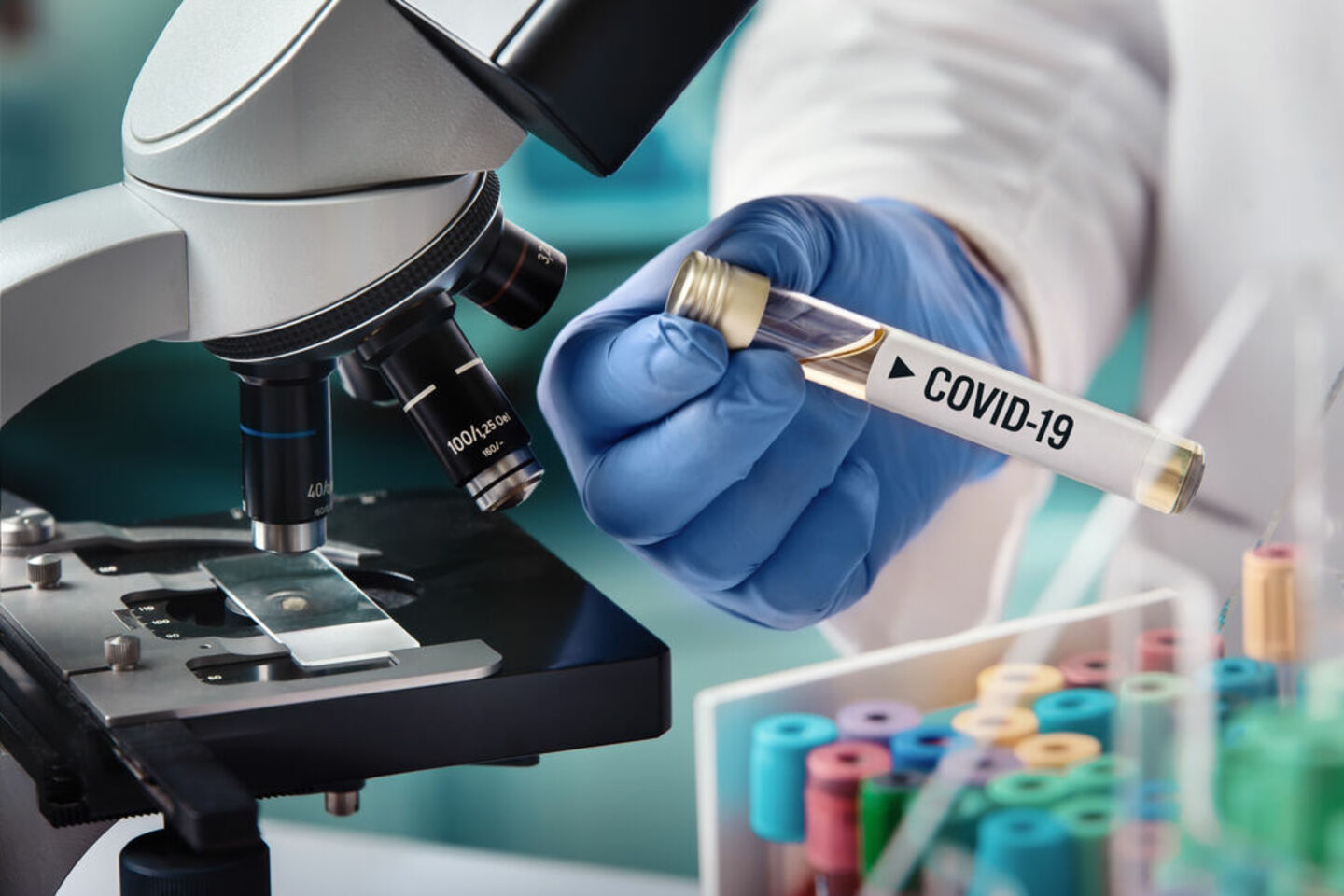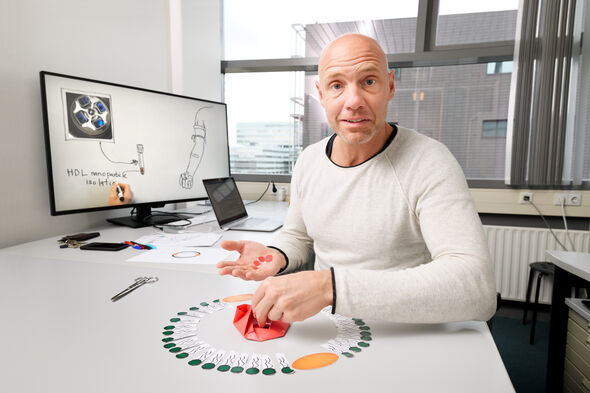
“We should now quickly scale up the number of tests”
We are doing our very best to minimize the spread of the new coronavirus, but without medicines to treat patients and vaccines that can prevent a new outbreak, the end of the corona crisis is not yet in sight. TU/e professor of Precision Medicine Willem Mulder gives his views on the medical possibilities for tackling the virus.
Let's begin with the question of what makes the present virus so special. Willem Mulder tells that most corona patients who do not survive the infection die of a complication known as acute respiratory distress syndrome. “This is a powerful inflammatory response whereby the lungs fill up with immune cells. In effect, these patients drown in the excess fluid in their lungs. The strength of this inflammatory response is truly unprecedented.”
The professor of Precision Medicine is himself an expert in the field of what is known as nano-immune therapy, and so this unusually vigorous reaction by the immune system has captured his attention. “The problem is that as yet we cannot inhibit this inflammatory response. That's why this virus is so dangerous,” Mulder points out. “And because it is a new virus, every one of us, in principle, can get it. In this scenario, even if only a small percentage of patients suffers severe complications, the absolute number of fatalities becomes very high. This may happen while the vast majority of those infected have only mild symptoms.”
This is why a way must be found as soon as possible to suppress the powerful inflammatory response suffered by the sickest patients, Mulder explains. “A rapid and cheap solution could perhaps be provided by hydroxychloroquine, an old antimalaria drug with an anti-inflammatory effect. This is now being widely reported, but no one knows exactly how it will work against the complications of COVID-19, nor how well.”
Names
In common parlance, both the new virus and the disease it causes are called ‘corona’. The official naming is a little more complicated: the pandemic is caused by a coronavirus called SARS-CoV-2. SARS stands for Severe Acute Respiratory Syndrome (referring to the severe breathing difficulties caused by the virus) and CoV for coronavirus (the type of virus). The new coronavirus is closely related to the virus that in 2003 caused an outbreak of SARS that occurred mainly in East Asia (and which is now known as SARS-CoV-1). The disease that SARS-CoV-2 causes is officially called COVID-19, which stands for COrona VIrus Disease, first identified in 2019.
Primitive medicine
As well as being a professor at TU/e, Willem Mulder is also head of the Nanomedicine Laboratory at the Icahn School of Medicine, the medical faculty of Mount Sinai Hospital in New York. Coincidentally, Raphaël Duivenvoorden, internist at the Radboud university medical center, working in collaboration with Mulder's American lab, recently discovered a protein that hydroxychloroquine appears to have an effect on. “He had been working on this for a year before COVID-19 appeared, but now he has received fast-tracked authorization to draw blood from corona patients being treated with hydroxychloroquine at the Radboudumc. In Nijmegen, Duivenvoorden has all the equipment and cooperation he needs to ensure that any results can be shared with the medical community as quickly as possible.”
Mulder sees a medicine like hydroxychloroquine as being a slightly primitive way of gaining a small degree of control over the immune system. “A more refined alternative does exist, namely the more costly approach based on drugs known as biologics. These are already being used to treat rheumatic diseases. In these diseases, too, the immune system becomes overactive, which results in the body's own joints being damaged. Obviously, rheumatic drugs are also being studied for their potential in combating COVID-19.”
If you inject patients with such antibodies, you can help them beat the virus; this is known as passive immunization
Antibodies are proteins produced by the body itself to fight a pathogen, a disease-causing agent. A few weeks ago it became evident that the Rotterdam professor and Spinoza Laureate Frank Grosveld, working with colleagues in Utrecht, had discovered an antibody against SARS that also appeared to be effective against COVID-19. This antibody, produced as a medicine by genetically modified mice, was being kept in the fridge and was as yet untested. “If you inject patients with such antibodies, you can help them beat the virus. It is a form of therapy known as passive immunization.”
To protect healthcare workers and at-risk groups against the new coronavirus, vaccines are essential in the long run; prevention is, after all, better than cure. “Traditional vaccines are based on antigens,” Mulder explains. An antigen is a molecule on the exterior of a virus or bacterium by which our immune system can recognize the pathogen. “A vaccine contains a weakened version of a pathogen, or a component of it, which our immune system is then stimulated to make antibodies against.”
If, later in life, a vaccinated person encounters that particular pathogen, it is immediately recognized and disabled: the vaccination has created an artificial form of immunity. In fact, the body reacts exactly as it would if you had had the disease and recovered from it. In that case too, you are usually no longer susceptible to the disease - for a certain period - nor can you pass it on to anyone else.
“Once it has been established that an antigen (or a combination of antigens) is suitable for making a vaccine, these proteins have to be produced on a large scale, which requires recombination in the lab,” says Mulder. “This involves a great deal of work; cells have to be genetically modified using a plasmid or via a viral vector, next these cells have to be grown on a very large scale. Once this cultivation is underway, procedures have to be developed for extracting and purifying the product. It will probably take at least a year to produce a vaccine like this in the traditional way.”
Genetic drugs
Yet is it possible that a vaccine will be available earlier than this. This is because companies are working on what are called genetic drugs, whose development involves searching in the genetic code of the virus for the piece of code that serves as the blueprint for an antigen. A vaccine could then consist of an injection of that piece of genetic code (mRNA), which would stimulate the body's immune cells to themselves produce the correct antigens.
“In principle this is a very quick method, because these days you can reveal the genetic code of a virus in no time at all with the help of sequencing,” Mulder explains. “The challenge is the next step: getting the mRNA into the antigen-presenting immune cells. This has not yet been done on a large scale for viral infections; genetic immunization is mainly used with immune therapy against cancer. BioNTech based in Germany and Moderna based in the United States are working on this.” At Moderna they started patient studies last week, and they say that their mRNA vaccine may well be available as early as this fall for (American) healthcare workers.
Also of interest in this context is the work of the Romanian-Dutch Spinoza Laureate Mihai Netea, Mulder tells. Although vaccines have traditionally been intended to enable our immune system to quickly recognize particular viruses or bacteria, vaccinations are proving even more beneficial than expected. “It was Netea who discovered ‘trained immunity’, a primitive memory function of our innate immune system. Trained immunity is the reason why vaccination against, for example, tuberculosis can have a protective effect against other types of infection. After vaccination, the innate immune system becomes temporarily more alert.”
In many countries, the BCG vaccination is included in the vaccination program for children, but not in the Netherlands because tuberculosis rarely occurs here. However, earlier studies in Africa have already shown the protective effect of the vaccination against other infections, which appeared to decline by roughly half. Supported by an ERC Advanced Grant, Netea was already planning to research in the Netherlands the extent to which the BCG vaccination can protect seniors against infections, but decided in January with Marc Bonten of the UMC Utrecht to conduct an accelerated test among healthcare workers, in the hope that a vaccination will enable them to stave off coronavirus for longer. “A further idea is that those who nonetheless contract coronavirus will get over their symptoms more quickly thanks to their activated immune system,” says Mulder.
Predictions
Willem Mulder has his doubts about the estimates made by Dutch health organisation RIVM. “At the end of January they estimated the likelihood of the virus coming to the Netherlands as extremely small. Likewise, their assumption that you are not contagious if you are displaying no symptoms was not supported by any evidence. Celebrating carnival wasn't thought to pose any problem at all since people supposedly socialize only with their close family and friends. Hopefully, the Dutch government's measures have been introduced in time.”
Personally, Mulder is inclined to be more cautious. It's no coincidence that he flew back from New York to his family in the Netherlands as early as February. A phone call in the second week of March with a surgeon friend based in Italy's northern city of Bologna further increased his skepticism. “‘You people are nuts,’ he said. ‘It's going to get out of hand in your country too.’ Healthcare in the north of Italy is on a par with Dutch healthcare, so there is no reason at all to suppose we won't encounter similar problems.”
Running
He feels positive about the current measures. “A temporary lock-down that still leaves scope to go for a run is fine by me. The main concern now is to quickly scale up the number of tests, to assess whether someone has COVID-19, as well as to establish whether someone has already had it. Only then can we check whether people have indeed become immune. Then people will also know whether they can safely be around corona patients or family members in the at-risk groups. Hopefully, this will get public life up and running again so that the disastrous economic consequences don't cause even more harm than the pandemic itself.”


Discussion